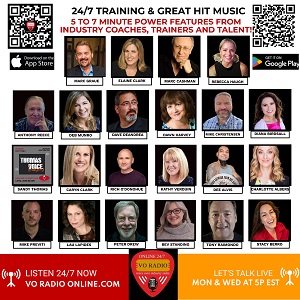|
VOICE OVER BUSINESS - PART 1 How To Turn Your Voice Over Career Dream Into A Money-Making Business  By Kim Handysides By Kim HandysidesVoice Actor & Coach Business. The word alone used to send icy shivers down my spine. But, to be a
professional artist, as in being able to write "artist" or "musician" or
"dancer" or "actor" on your annual tax forms (aka more money coming in
than going out), you must understand your talent or product IS your
business. Perhaps it was my childhood, growing up lean, but I've always
had a healthy respect for money - and when I began cashing checks, I
thought of my voice work/acting as my business. But when I began running
my voice over gigs like a small business, I noticed a huge shift. And
took it to the next level.
I had the advantage of watching and learning from my husband who
studied Commerce at McGill and ran a successful recycling business for a
couple of decades. His bizzy side rubbed off on me, and this is when I
learned what one should do to take on that small business mentality and apply
it to your art/dancer/musician/acting business.
1. GOALS: Set Them. Start long term and work backward to short term. What do you want to
have accomplished 10 years from now, 5, 2, and in one year? Break them
down as much as you can by filling in steps that you will need to take to
accomplish them.
2. BUSINESS PLAN: Come Up With One. To create a business plan, you forecast what sales you will be able
to make. This is part of your goal setting, but now you are putting it
in another form.
You
create a kind of budget, and estimate not only how much you'll pay
out and how much you'll bring in, but where your sources of work will come
from, and how you'll budget your time, including whatever
equipment/resources you need to make it work.
3. SALES: Make Them. Easier said than done? Sales goes hand in hand with marketing and its
set of related tools that you'll need to create your marketing
plans/materials. If you've never done sales before, it's a great idea to
either read up on it and/or make one of your supporting jobs in
something like retail sales. You have a product (or service), your
client has a need, you want to close the deal. It sounds so foreign to
an artist, but when you substitute the words of our trade, it makes more
sense. You have a song (or audition piece, or sculpture), your client
(or producer or director or dealer) has a need (to sell your song, cast
his film, showcase your work) and you want to close the deal. Make sure they pick you - so you can make money at your art and then go
make more of it. Closing the deal often involves more than your talent.
It involves finesse:
I asked one of my clients
once why they regularly hired me as the voice over actor for their
advertising campaigns, and they said, "Because we know you deliver the
right read, in the time frame, on budget, every time."
4. MARKETING: Make It Reflect YOU. Twenty years ago everyone needed to have business card. Perhaps
business post cards. Five to 10 years ago, to be considered serious,
you needed to create a website. Even one page. The must-have now is a
video on your website. That's just so you can be found. And there are social
media sites to consider. LinkedIn, Facebook, Twitter, Instagram. Pick
one and make it yours. Don't forget one-to-one marketing communications.
People who market in the arts appreciate creativity. So have fun with
your marketing plan! Personal example:
5. FINANCIAL CONTROL: Keep It. Your dollars-in have to be more than your dollars-out. As an artist,
one of the ways I have been able to thrive is to squirrel away money for
the slow times. Learn about money so you can make what you have grow,
and be smart where you spend it. My car is always second-hand, and that's OK. It means I can afford the kind of vacation I want. I make my own
coffee and pizza and reinvest in equipment, marketing materials, courses
and coaches.
6. DISCIPLINE: Develop It. Yes, with your craft. Work on it every day. But also work on the more
practical aspects. Your invoicing, your banking, your marketing, your
taxes. Doing a little every day will avoid the springtime dread and horror
of a week to 10 days of sifting through receipts and sorting out your
tax stuff. If it helps, enlist a partner or group to keep you on
track. In my accountability group,
we check up on each other and hold the rest accountable on five weekly
goals:
Build yourself a
schedule. A flexible schedule, if you like, but make it as unshakable as
brushing your teeth or putting on deodorant everyday.
Start thinking of your art as your small business and acting like it
is one. See if it doesn't bring you greater returns, more joy and
more time and love for your art and craft. ----------------- ABOUT KIM Kim Handysides is a top voice over artist in commercials, eLearning and narration. With a background in theatre and film and a thorough grounding in radio and television, she's a 2019 Voice Arts Awards winner and five-time nominee, and "loves sharing advice, tips and experience with anyone who asks." She is also a voice over coach, offering private coaching and group study classes - and loves dogs, mountains, beaches and story. |
|
|
Tell Us What YOU Think!
Please Note: Since we check for spam, there will be a slight delay in the actual posting of your comment.
Comments (1)
Carlin Tools
10/30/2020 at 11:20 PM
Great article, it gives you a good resource to start building your business.



.gif)


.png)



click for new article alerts